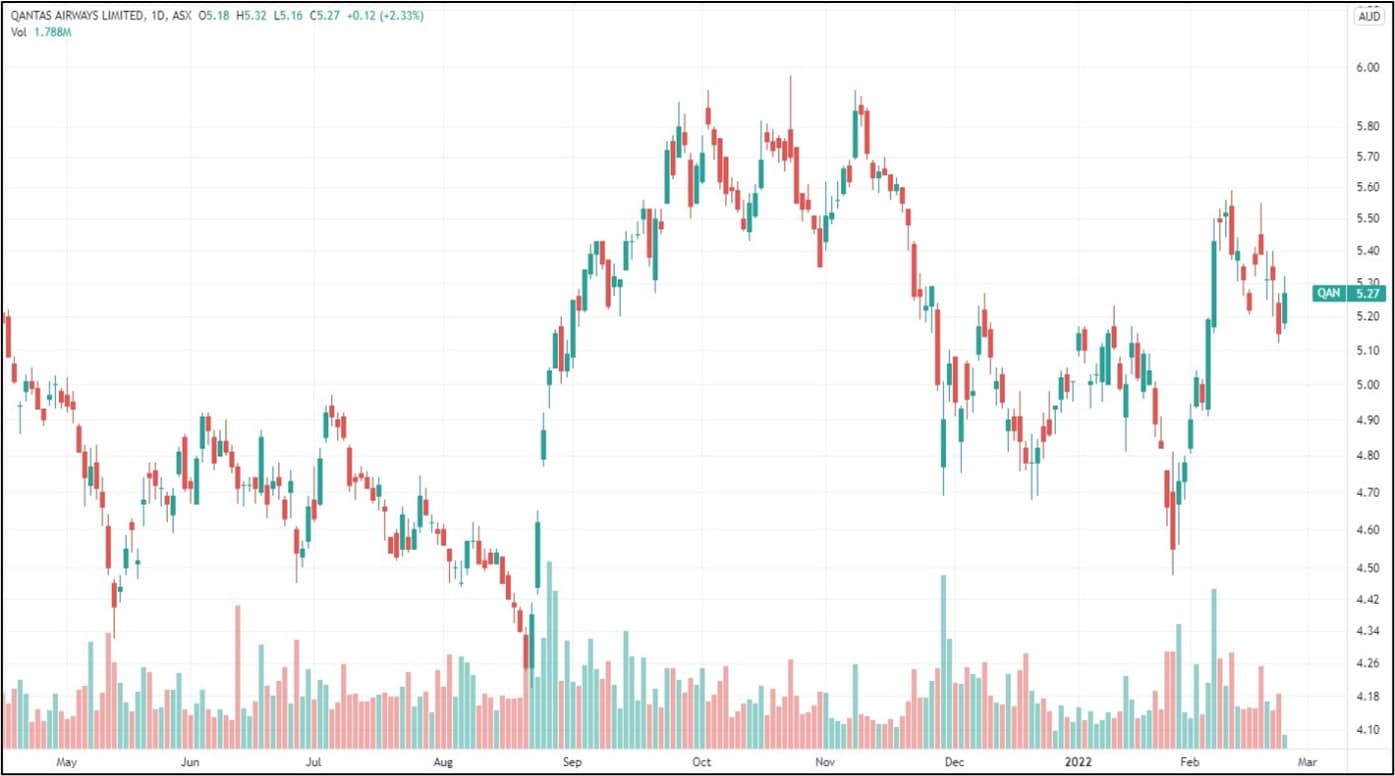Qantas (ASX: QAN): In the right direction, but not off the ground yet
![]() Marc Kennis, February 24, 2022
Marc Kennis, February 24, 2022
Qantas shares more than doubled from their COVID-bottom, still below pre-COVID highs
Qantas released its half-yearly results on Thursday, revealing just how its recovery is proceeding. As with its peers in the travel industry, the pandemic all but wiped-out passenger numbers and it has been a long and slow road back, impeded by border closures and new strains of COVID-19. The recent half-yearly period finally saw Australia’s international border and numerous state borders re-open, but the Omicron strain still dented passenger demand. Will the next phase of the recovery for Australia’s flag carrier be smoother?
COVID-19 decimated Qantas
The airline industry is notorious for being highly capital intensive and vulnerable to external shocks. Virgin Atlantic founder Richard Branson once illustrated this point by declaring the way to become a millionaire was to start as a billionaire and then start an airline.
In FY19, the last full financial year unaffected by COVID-19, Qantas was an exemption to that argument, generating $17.96bn in revenue, $3.36bn in EBITDA and a pre-tax profit of ~$1.3bn. But COVID-19 swung things in the wrong direction. Even in FY20, when COVID-19 only affected the company for four months, it took a $4bn revenue hit. And while it recorded a $124m pre-tax profit, aircraft write downs resulted in a statutory loss of $2.7bn. In FY21, it suffered a $12bn revenue hit and a statutory loss of $2.35bn.
However, Qantas managed to survive the pandemic thanks to its Recovery Plan. The most prominent aspects were its Mascot property sale and worker redundancies (there have been 9,800 since July 2020), but it also included debt reductions and aircraft hibernation. Despite recording a substantial loss in FY21, the company committed to refreshing its domestic fleet with Airbus A320s, A220s and A321s. And today Qantas told investors it had officially resumed work on its Project Sunrise program, implying an order for aircraft to fly non-stop to London and New York from Sydney and Melbourne is imminent. The company was also helped by its strong Loyalty division, which holds its frequent flyer program and was its only profitable division in its recent half yearly result with $127m in EBIT.
Qantas’ recovery a Work in Progress
Qantas’ share price fell from over $7 in late 2019 down to $2.36 in late March 2020. The company’s share price slowly recovered over the following months, but since November 2020 has been volatile and never surpassed its pre-COVID high. This share price performance was due to the hope that travel demand would eventually recover to pre-COVID levels, but the reality is that this is not anticipated until 2024. The closure of Australia’s border meant that domestic flight levels briefly recovered to pre-COVID levels during 2021, but the Delta wave eroded demand again.
In late 2021, the border was opened, but international travel demand levels remain low and the Omicron wave has impacted demand domestically. In the March quarter, Qantas is forecasting capacity to be at 68% of pre-COVID levels, rising to over 90% in the June quarter. International capacity is expected to be just 22% of pre-COVID levels, doubling to 44% in the June quarter.
The Omicron wave hit Qantas’ share price, but shares have recovered and found support above $5. Today’s results caused a 2% drop in the share price, but the buyers have a slight edge in trading momentum.

Qantas share prices last 12 months (Source: Tradingview)
Hoping business travel will take off again
Qantas’ half yearly results depicted that there’s still some way to go. The company made an underlying EBITDA loss of $245m and a statutory loss of $622m, although it recorded positive statutory net free cash flow supported by Qantas Loyalty and Qantas Freight.
Consensus estimates for FY22 forecast revenues of $8.4bn, followed by $15.8bn in 2023 and $18.3bn in 2024 – surpassing pre-COVID levels in that year. EBITDA is expected to nearly reach pre-COVID levels in FY23 with $3.2bn forecast, although EBIT will be lower considering the extent to which depreciation is relied upon by airlines such as Qantas.
The bulk of travel for the foreseeable future will be leisure bookings with business travel lagging – corporate bookings are at just 33% of pre-COVID levels. Corporate bookings are higher margin customers for airlines because they tend to book closer to the time of departure and willingly pay a premium for the privilege. Undoubtedly, the company is hoping that the end of work from home mandates will quickly lead to business travellers taking to the skies once more.
Ready for take off
Assuming no further capital raises are undertaken, this gives Qantas stock a P/E ratio of 14x for FY23 and 8x for FY24. One could be concerned about the competitive landscape domestically – with low-cost airline Bonza set to launch later this year – and internationally as more airlines return to Australia.
We also believe that the recovery in air travel will continue in 2022 as countries remove their travel restrictions. Although the IATA estimates air travel remained 59% below pre-COVID levels in 2021, the industry body also reported a substantial increase in demand in the first two weeks of February when numerous governments lifted restrictions. Specifically, ticket sales rose from 38% of pre-COVID levels in the first week of February to 49% two weeks later – this was the biggest 2-week increase in ticket sales since the crisis began.
While Qantas investors will inevitably feel more turbulence, we believe there remains light at the end of the tunnel and QAN could be good buying around these levels.
Stay up-to-date on ASX-listed stocks!
Make sure you subscribe to Stocks Down Under today
No credit card needed and the trial expires automatically.
Frequently Asked Questions about Qantas
- Does Qantas pay a dividend?
Before COVID, in FY19, Qantas paid a dividend of $0.13 per share. We expect the company will reinstate dividend payments at some stage, once business is humming again.
- Is Qantas a good stock to buy right now?
At current share price levels (February 2022), we believe Qantas can be a good stock to hold in portfolios for the longer term.
- Where is Qantas based?
The company is based in Mascot, NSW.
Blog Categories
Get Our Top 5 ASX Stocks for FY26
Recent Posts
Intel Beats Earnings: What It Means for ASX Data Centre Stocks
Intel’s surprise profit and strong results show that demand for data centre infrastructure is booming, which is great news for…
ASX Uranium Stocks Rally as Nuclear Power Goes Mainstream: 3 Producers to Buy
The uranium sector just got its biggest validation in decades. Amazon, Microsoft, and Google have collectively committed billions to nuclear…
AI Power Crunch: 3 ASX Stocks Positioned to Win from Soaring Data Centre Demand
Amazon just dropped a $20 billion commitment to expand its Australian AI infrastructure, and the announcement has reignited interest in…


